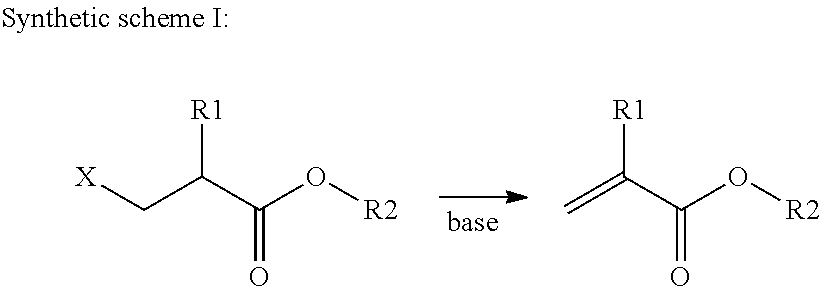Preparation method of copolymerizable photoinitiators
a technology of copolymerizable photoinitiators and copolymerization, which is applied in the field of copolymerizable photoinitiators, can solve the problems of high cost, limited stability, and high reactiveness of (meth)acryloyl chloride, and achieves simple preparation method and high purity.
- Summary
- Abstract
- Description
- Claims
- Application Information
AI Technical Summary
Benefits of technology
Problems solved by technology
Method used
Image
Examples
example 1
[0054]This example illustrates the superior selectivity and the ease of isolation procedure when using a suspended inorganic base instead of a nitrogen base.
[0055]This is exemplified by the synthesis of 4-(2-acryloyloxyethoxy)phenyl-2-hydroxy-2-propyl ketone.
Synthesis of the Intermediate INT-1
[0056]INT-1 or 4-(2-(3-chloropropionyloxy)ethoxy)phenyl-2-hydroxy-2-propyl-ketone was prepared as follows: 40.4 g (0.18 mol) 4-(2-hydroxyethoxy)phenyl-2-hydroxy-2-propyl-ketone (DAROCUR™ 2959) was dissolved in 560 ml acetone and 29.1 ml (28.5 g, 0.36 mol) pyridine was added. The reaction mixture was cooled to −10° C. and 34.4 ml (45.7 g, 0.36 mol) 3-chloropropionyl chloride was added over 40 minutes, while the temperature was kept at −10° C. The reaction was allowed to continue for 24 hours at room temperature. 400 ml water and 450 ml ethylacetate was added and the mixture was stirred until all precipitated salts were dissolved. The organic fraction was isolated, dried over MgSO4 and evaporated...
example 2
[0065]This example illustrates the influence of the type of inorganic base used on the reaction INV-2 of EXAMPLE 1.
Synthesis
[0066]The reactions and the determination of the % conversion were performed in the same way as described in EXAMPLE 1, except that different types of inorganic bases were used in the reaction mixtures according to Table 6 and Table 7. The amount of the components used is given in g, with the exception of acetone which is given in ml. The reactions were carried out in an RS10 parallel reactor (Barstead STEM™) using 1.5 equivalent of inorganic base for 1 equivalent of the intermediate INT-1.
TABLE 6Amount used (in g)ComponentEq.R1R2R3R4R5INT-111.31.31.31.31.3Na2CO3 anh.1.50.6————K2CO3 anh.1.5—0.8———KHCO3 anh1.5——0.6——Na2CO3•10H2O1.5———1.7—Na3PO4•12H2O1.5————2.3BHT0.0090.0090.0090.0090.009Acetone (in ml)1313131313
TABLE 7Amount used (in g)ComponentEq.R6R7R8R9INT-111.31.31.31.3NaOAc•3H2O1.50.8———K3PO4•3H2O1.5—1.6——KOAc anh.1.5——0.6—K2HPO4 anh.1.5———1.0BHT1%0.0090.00...
example 3
[0072]This example illustrates that the method according to the present invention is applicable to other initiators. The required intermediates were prepared without optimizing the reaction circumstances.
Synthesis of 4-acryloxybenzophenone (INI-3)
[0073]
[0074]6.7 g (35 mmol) of 4-hydroxy-benzophenone was dissolved in 100 ml methyl ethyl ketone. 4.2 g (42 mmol) triethyl amine was added and the mixture was cooled to −10° C. 5.3 g (42 mmol) 3-chloro-propionyl chloride was added drop wise, while the temperature was kept below −5° C. The reaction was allowed to continue for 30 minutes at 0° C. and 3 hours at room temperature. The precipitated salts were removed by filtration and the solvent was evaporated under reduced pressure. 3-Chloro-propionic acid 4-benzoylphenyl ester was isolated by preparative column chromatography on a Prochrom LC80 column, using n-hexane / ethylacetate 75 / 25 as eluent at a flow rate of 150 ml / min and Kromasil 60A 10 micron as silica. 1.2 g of 3-chloro-propionic ac...
PUM
| Property | Measurement | Unit |
|---|---|---|
| temperature | aaaaa | aaaaa |
| temperature | aaaaa | aaaaa |
| temperature | aaaaa | aaaaa |
Abstract
Description
Claims
Application Information
 Login to View More
Login to View More - R&D
- Intellectual Property
- Life Sciences
- Materials
- Tech Scout
- Unparalleled Data Quality
- Higher Quality Content
- 60% Fewer Hallucinations
Browse by: Latest US Patents, China's latest patents, Technical Efficacy Thesaurus, Application Domain, Technology Topic, Popular Technical Reports.
© 2025 PatSnap. All rights reserved.Legal|Privacy policy|Modern Slavery Act Transparency Statement|Sitemap|About US| Contact US: help@patsnap.com



